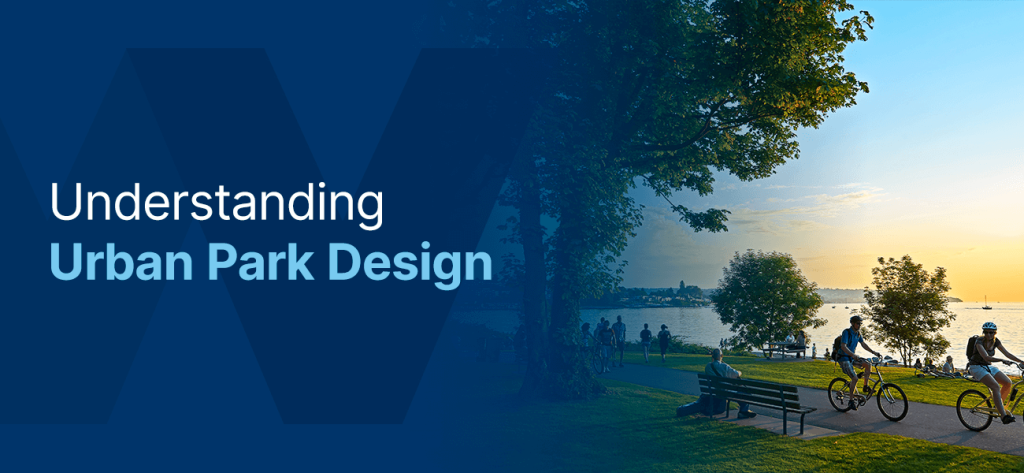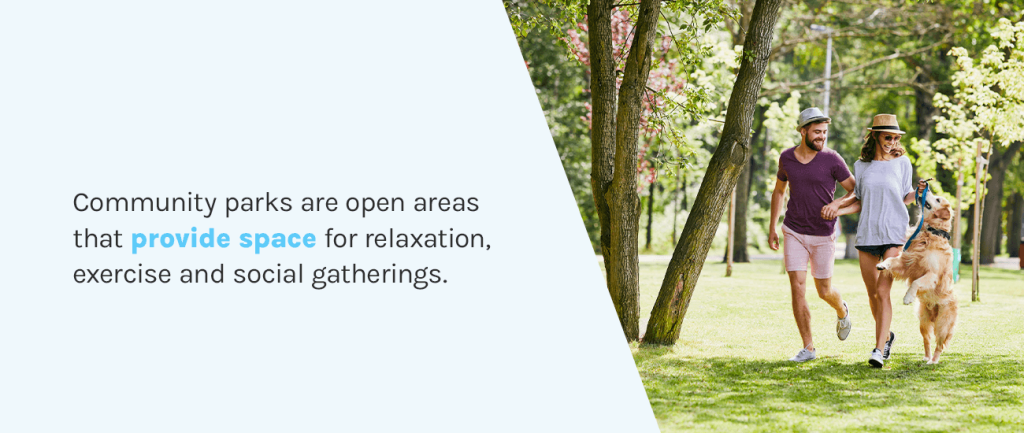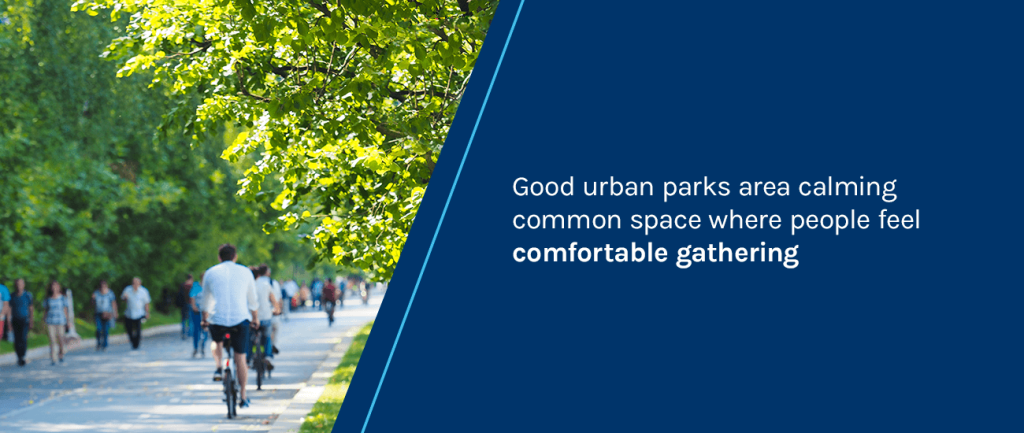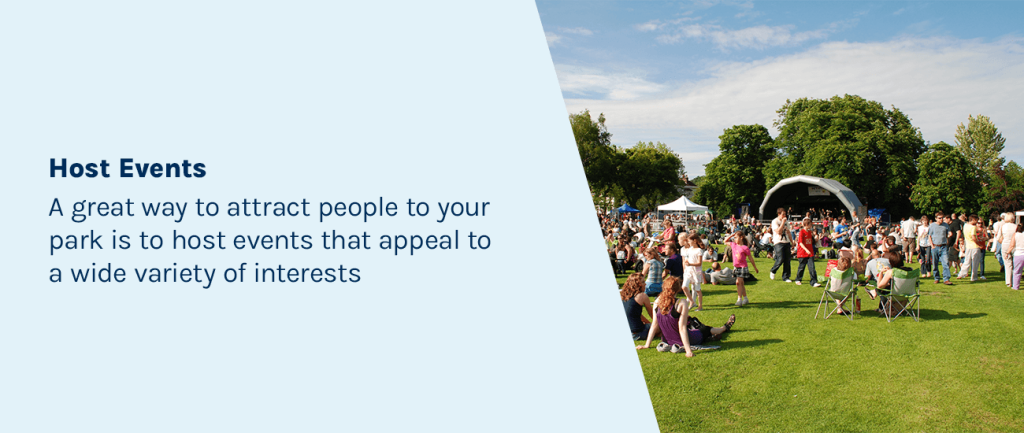Understanding Urban Park Design

Parks & Rec | Jan 10, 2022
Urban parks are beneficial and even critical parts of cities and communities. They provide residents and visitors a place to relax, exercise and have social interaction with neighbors, friends and family. They’re a great place to escape the stress and noise of the city. How can you design an urban park that makes the most of the space it has? Many factors go into an effective urban park design.
Read the full article or jump to a specific section:
- Benefits of Urban Parks
- What Makes an Effective Urban Park
- How to Design an Urban Park
- After Your Park is Built
- Contact Wabash Valley Site Furnishings
Benefits of Urban Parks
Community parks are open areas that provide space for relaxation, exercise and social gatherings. They often include playgrounds, picnic tables and walking paths. An inner-city park is the heart of its community. These urban parks are located in the center of busy streets and are surrounded by towering buildings. They’re sometimes the only open and green area for blocks or miles. Parks provide many important benefits, but they can be even more important in urban areas.

An urban park:
- Provides a place for rest and relaxation.
- Encourages spontaneous social interaction and social gatherings.
- Gives community members access to nature.
- Promotes physical exercise.
- Can reduce neighborhood crime.
- Improves air quality.
- Supports biodiversity.
- Helps control temperatures and humidity.
What Makes an Effective Urban Park
As communities begin to realize the important benefits of parks, more and more urban parks are being designed. However, there are many factors that park planners should consider so that they end up with an effective and maximally beneficial urban park. They need to be at the center of the neighborhood so that they are accessible by most residents with just a five-minute walk.
Urban parks need to look inviting and open. They should be surrounded by sidewalks and public areas, and not be too close to residential areas. A park backed up against houses can cause confusion between the private and public spaces. A public transit stop should be nearby, as should some shops and public buildings.
Parks should retain the natural curves and hills of the land. In urban areas, it’s impossible to see what the land looked like before being built over. If it’s possible, parks should maintain the natural contour of the land that was there before.
Good urban parks are more than just open areas of grass. They’re a calming common space where people feel comfortable gathering. They have functional and attractive amenities, but the park doesn’t feel overdesigned and cramped. People should be able to see through the park and be able to walk through it easily. This is important for safety and also keeps the park from being overdesigned. Parks should also have adequate lighting so that people can enjoy the park for more hours.

How to Design an Urban Park
Designing an urban park is an important task that requires careful planning. Urban parks are typically smaller than their suburban counterparts, so it’s critical to maintain a balance between open space and designed elements. You have to consider location, audience, design specifications, noise levels, land development, playground equipment, lighting and site amenities.
Choose a Location
First, you need to choose a location for the new park. If you’re developing in an urban area, you likely don’t have many options. However, the park should be centrally located. Urban parks are the most effective when they are within a five-minute walk of most residents. The easier it is to get to, the more use it will get. Is it easily accessible by walking, biking or taking a car or public transportation? Consider the location of nearby transit stops, stores, public buildings and parking lots.
When choosing a location, you’ll also need to keep safety in mind. Pick a place that has a low crime rate and high visibility. People should be able to see completely through the park and be able to walk through it to get to another destination. People need to feel safe in that area. You also may be able to choose a location that has extra character. Consider if there are any available locations that offer something unique or have historical significance. This could draw in even more people to your park.
Determine the Target Audience
Once you determine a location, you’ll be able to learn more about the needs of the community there. Find out about the demographics of the area. Are there a lot of children, elderly people or working adults? Learning more about the people who will be using the park can help you prioritize what the park needs. Different people would benefit more from different elements, but you’ll only be able to include a few things to fit in your available space.
Areas with families with children would benefit from playgrounds, swing sets and play areas. Seniors and adults might prefer walking loops and areas to relax. If there are a lot of pet owners in the area, consider including a dog park. If you’re near a high school or college, you could add areas for studying and basketball courts for friendly competition.
You can even include the community in the planning process. Invite the community to share what they would want in a park. This can help you gain community support and limit community backlash. Ask for ideas, likes and dislikes. This is the best way to develop a park that the community wants to use.
Design Your Park
Now that you have an idea about the space you’ll have and the market you need to serve, you can start designing your park. Make a list of the elements you absolutely need to include. Most urban parks will have a playground, a walking path and seating areas. If you have a smaller area of land you can use, this may be all you can include.
When designing your park, you’ll have to consider the budget. Most people don’t know the cost of many aspects of developing a public park. You’ll need to partner with several businesses to help bring your dream into a reality. You’ll need a land developer, playground manufacturer and a site furnishings provider. Partner with a park designer to help you make the most of your space.
Reduce Noise Levels
Urban parks are surrounded by bustling city life and traffic noise. Effective urban parks are able to block out some of this noise. Including plenty of vegetation, trees and bushes can help reduce the noise pollution of the area. Vegetation helps reduce noise through sound attenuation.

Another way to block out loud city noises is to add a water feature to your park. The sound of flowing water has a calming effect and helps block out unwanted background noise. It will help people separate themselves from their stressful and busy surroundings. You could include a fountain, waterfall or even a splash pad.
Prepare the Land
Preparing the land can involve a number of different steps depending on what you’re starting with. You’ll want to maintain the natural contours of the land and leave greenery and trees. It should still feel like being in nature no matter how small the park is. Determine where the walkways will be. A loop that goes around part of the perimeter but also goes through the trees and quieter, middle part of the park is the best way to incorporate a walking path.
If you’ll be including a playground, you will need to flatten that area. The pit will have to be dug out and then filled with the appropriate amount of surfacing material. This could be unitary surfacing or loose-fill surfacing, such as rubber mulch. The depth of surfacing that is required depends on the height of the equipment you choose to add.
You’ll also likely need to have landscaping work done. A bright and beautiful environment will help attract visitors to your park. Add attractive flowers and shrubs along walkways, near entrances and around seating areas. Your visitors will enjoy seeing the colorful plants and feeling connected with nature. Depending on your area, you may also need sprinklers to keep the park looking nice.
Add Equipment
Playground equipment is often the staple of community parks. Children can develop essential social, physical, cognitive and emotional skills while playing on park playgrounds. The best playgrounds have a variety of types of equipment. Include the classic elements like swings, slides, climbers and tunnels. Try to include unique elements as well, like custom play sculptures or themed playsets.

Make sure to check that all equipment adheres to strict safety standards. Partner with a playground designer that can help you pick the right setup and equipment for the space and budget you have available.
Don’t Forget Lighting
Lighting helps highlight your landscape, extends the park’s usable hours and increases safety. Your urban park will require three levels of lighting. First, you will need full, bright lighting in the highly used areas of your park. This typically includes playgrounds and walkways. Next, you’ll need accent lighting. Use accent lighting to highlight the attractive features of your park, such as water elements, trees, landmarks or artwork. Last, you’ll need safety lighting. This consists of lowly-lit places that would normally seem unsafe at night.
Include Site Amenities
No park is complete without site furnishings and amenities. These elements are critical in making your park comfortable and functional.
Benches
Benches are a critical part of designing an urban park. You’ll need to have benches spread out over the whole area. They should be placed along walking paths to give people a place to rest and relax. You’ll also need benches facing playgrounds and dog parks so that parents can comfortably supervise their kids or dog. Place some benches in the shade and others in the sun so that people can maintain whatever temperature is comfortable for them.

You’ll also have to choose the style and material of your benches. There is the traditional wooden park bench, elegant metal benches and a variety of plastic benches. They all can come in many designs, all with different levels of comfort and attractiveness. Check out our guide to choosing the right bench.
Picnic Tables
Picnic tables give people a place to sit, eat and socialize while enjoying your park. Picnic tables can be grouped together or spread out over the park. It’s up to you. When picnic tables are all together, people will gather to eat or hang out in groups. Spread-out tables allow families or friends to gather away from other visitors.
Choose picnic tables that match or complement the style of your benches. This helps create a cohesive look that makes your park stand out from other areas. Read our tips for choosing the best picnic table.
Trash Receptacles
Trash receptacles help keep your park clean and attractive. Regularly spaced and highly visible waste receptacles will encourage people to throw away their trash and keep the park clean. Learn more about choosing trash receptacles for your park.

Shade Structures
Shade helps protect your visitors. Sunburn is often a concern of park users, but people may not pack sunscreen for a short park trip. To help keep park visitors comfortable and more protected from sunburns, your park should contain multiple shade elements. This can include trees, but it also can include shade structures and commercial umbrellas.
Additional Amenities
Additional amenities in your park can make it even more appealing. You might consider adding:
- Bike racks: Bike racks will allow people to bike to your park and lock their bikes up safely. This encourages visitors who may be too far away to walk and also gives people an outlet for physical exercise. People will feel much better knowing they can ride to your park and lock their bike up at a bike rack while they eat, relax or explore.
- Grills: Having an accessible grill can make your park a perfect place for social gatherings. People will love having an open and attractive place where they can host family gatherings and cook on a grill with their friends.
- Game tables: These offer an easy place for people to interact and play games together. Game tables are like picnic tables but they have chess/checkers board painted onto them. This encourages visitors to bring their chess, checkers or other board games to your park. Installing game tables actually comes with many benefits.
- Recycling receptacles: Recycling binsallow visitors to clean up the park while also protecting the environment. You can place recycling cans next to trash cans, especially near eating areas. They should be clearly marked with what type of waste is allowed in them.
- Hand sanitizing stations: Hand sanitizing can help keep your community safe by preventing the spread of germs at your park. Install hand sanitizer dispensers near eating areas, entrances and playgrounds.
After Your Park Is Built
After you design and build your park, you’re still not done. Parks require regular maintenance and may need renovations after a few years. You also need to ensure people actually use the park, since that was the whole point in building it. You’ll have to market the park, host events and encourage visitors.

Continue Maintenance
Parks need a lot of regular maintenance. If you have a playground, you’ll need to complete many maintenance checks. Check the equipment for any sharp edges, loose pieces, rust and splinters. If the playground has loose-fill surfacing, it will need to be regularly raked and evened out. Occasionally, you may have to add more surfacing to maintain the proper depth and cushioning. The maintenance crew should also clean and disinfect highly-touched surfaces.
The landscape will also need to be maintained. The grass will need to be mowed, bushes trimmed back and flowers tended to. Leaves and fallen branches will need to be cleaned up. If there are any restrooms on the premises, they will also need regular cleaning and maintenance. Some site amenities also require maintenance. For example, wooden benches and tables may need to be varnished or painted yearly.
Market the Park
While you may get many visitors when the park first opens, you may reach a point when numbers are dwindling. Your park can only provide people with its benefits if they actually use it. Marketing your park to the community is important for your park as well as for them. Consider hosting shows, events, classes and other activities that attract visitors. Post flyers around the park and in neighboring businesses.
A park website is another great marketing tool. People often try to check the website ahead of going to see if there are events. Your visitors may also want to host their own events at your park, so it’s important to include that information in a place where people can easily find it.
One of the best ways to market your park is to emphasize the benefits it provides. Educate your community on the benefits of physical exercise, spending time in nature and socialization.
Host Events
A great way to attract people to your park is to host events that appeal to a wide variety of interests. You can host events and allow visitors to host their own. Some events that you could host include:
- Yoga classes.
- Flower/tree planting events.
- Concerts and performances.
- Ecology walks.
- Movie nights.
If you have any covered pavilions or spaces for groups, you can also rent them out for people of the community to use. Allow people to call or schedule times on the website to reserve the space.

Install Public Artwork
Public artwork makes your park more unique and interesting while also connecting the site to people of the community. You can choose to install a large, site-defining piece of art, or have multiple temporary art installations. Regardless of what you choose, it should be connected to the community or the site itself.
Consider Chicago’s Cloud Gate, a large piece of art in Millennium Park. It is a huge piece of art that attracts tourists and locals alike. It also definitely makes the park stand out. However, you don’t need to have a big budget to make a big impact. Temporary art installations could even consist of work from local students.
Renovate
As time goes on parks can start to look old and boring. To liven up the park again, you may need to complete some renovations. If some areas are not being used as much as they once were, survey the community and see if there is something else that could serve their needs better.
Sometimes older parks are even dangerous, especially if there is outdated playground equipment. Unsafe playground equipment can cause severe injuries to kids. Walkways can become tripping hazards, and overgrown greenery can attract pests. Regular maintenance can help you avoid having to renovate your park for safety reasons.

Contact Wabash Valley Site Furnishings
Wabash Valley Furnishings specializes in the site amenities your park needs to be functional and attractive. Every park needs benches, tables, trash receptacles and other furnishings that just make the park easy to use. Our products are durable, high-quality and designed to require minimal maintenance. Our customization options make it simple to create a cohesive and attractive theme for your entire park.
Whether you’re designing a new park or renovating an existing one, our site amenities can enhance your park’s functionality and aesthetic. When you’re ready to take your park to the next level, reach out for a quote from Wabash Valley Site Furnishings. Our experienced team has worked with architecture, landscape architecture and design firms to put together site amenities and furnishings for a wide range of park projects. We will work with you to create an order that fits your specifications, design and budget.
Categories
Recent Posts
Sign up for our newsletter
Share this post: